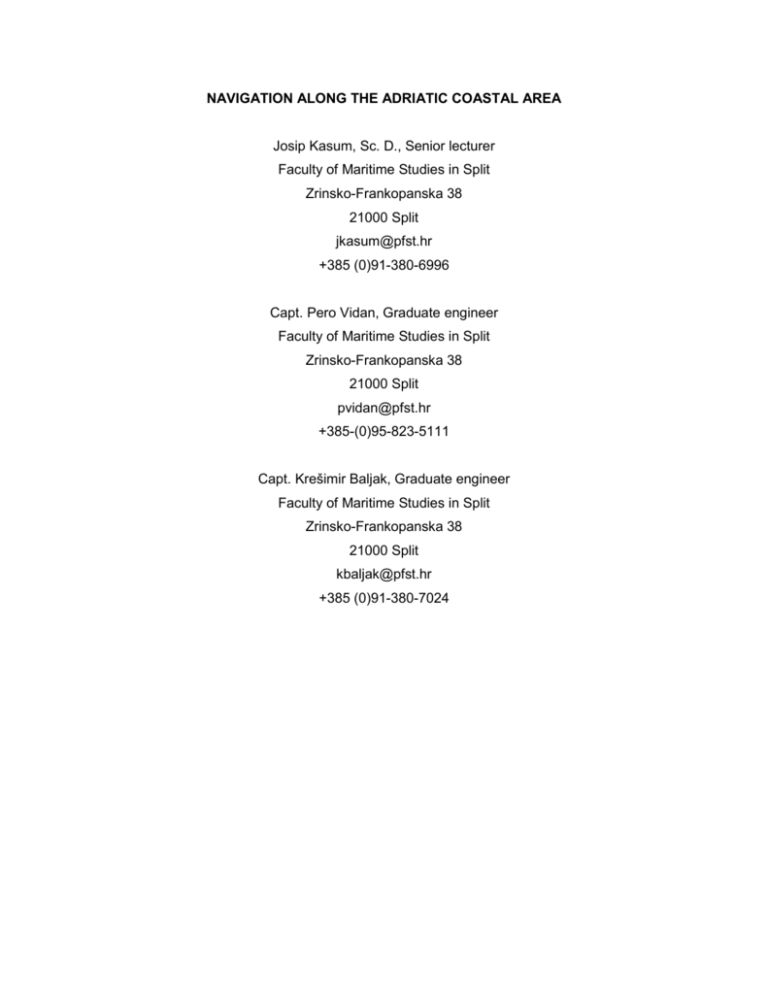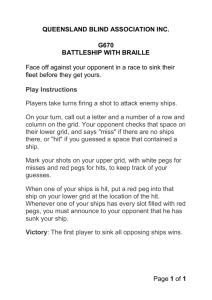Meteorological station
advertisement

NAVIGATION ALONG THE ADRIATIC COASTAL AREA Josip Kasum, Sc. D., Senior lecturer Faculty of Maritime Studies in Split Zrinsko-Frankopanska 38 21000 Split jkasum@pfst.hr +385 (0)91-380-6996 Capt. Pero Vidan, Graduate engineer Faculty of Maritime Studies in Split Zrinsko-Frankopanska 38 21000 Split pvidan@pfst.hr +385-(0)95-823-5111 Capt. Krešimir Baljak, Graduate engineer Faculty of Maritime Studies in Split Zrinsko-Frankopanska 38 21000 Split kbaljak@pfst.hr +385 (0)91-380-7024 ABSTRACT According to the Maritime Act (Official Gazette 6/97), coastal navigation along the Adriatic Sea is international navigation along the Adriatic Sea and the waters accessible from the sea up to the line which connects the cape Santa Maria di Leuca, cape Kefali (island of Corfu) and cape Skala (by the Butrinski Bay), during which the ship does not sail further than 20 Nm from the closest coast, land or islands. When planning the navigation between the eastern and the western Adriatic coast, the aforementioned coasts of land or island do not include the coast of the island of Palagruža, Galijula, Pianosa, the islands of Tremiti, the island of Sazan and the Albanian coast from the cape Gjuhes (Sqepi and Gjuhes) to the cape Panormes (Sqepi and Panormes). The Adriatic Sea is characterised by intense cyclone activities, especially in winter period, when winds of various directions and intensity blow. In terms of the wave size and wind force, the Adriatic Sea belongs to closed sea category. The winds and waves do not cause significant problems to larger ships. Coastal navigation ships and long coastal navigation ships of over 500 GT are legally subject to pilotage and required to respect he area of separate traffic. The covenants published in the Official Gazette 28/1997 and 117/1998 do not permit the navigation along the channels of Pelješac and Koločep, the navigation in parts of Srednji kanal, the Murter Sea and Žirje channel. Thus coastal traffic during heavy weather conditions in winter is interrupted. In this paper the authors analysed the system of navigation and control in the part of the Adriatic which belongs to the national territory of the Republic of Croatia. Meteorological and oceanographic data analysis is provided. It is proposed to allow navigation along the channels of Pelješac and Koločep, parts of Srednji kanal, the Murter Sea and Žirje channel to ships above 500 GT which are not loaded with hazardous cargo and do not have limited draft, and which, because of weather conditions, are not allowed to sail along the ordinary allowed routes, although their hydrographic characteristics allow navigation along such areas. 1. System of navigation and control in the Croatian Adriatic According to provisions of Articles 76-101 of the Maritime Act, the categories of navigation of a maritime ship, depending on the size, construction, devices, equipment and other technical conditions, are the following: Unrestricted navigation, Long coastal navigation, Short coastal navigation, Coastal navigation along the Adriatic, National navigation, National coastal navigation, National inshore navigation, and Local navigation. All the listed categories of ships navigate along the Adriatic. The main navigational routes are NW-SE and SE-NW, and go through the middle of Adriatic (Figure 1). They are compulsory for all the ships with hazardous cargo. Such ships have the obligation to navigate following the system of separate navigation. By implementing the International Ship and Port Facility Security Code-ISP the International Maritime Organisation-IMO recommended the use of Automatic Identification System-AIS for certain categories of ships. Special provisions regulate the navigation through the passage into the port of Šibenik along Pašman straits, Mali Ždrelac and Vela vrata, along the rivers of Neretva and Zrmanja, and prohibition of navigation along the channels of Koločep and Pelješac, along parts of Srednji kanal, the Murter Sea and Žirje channel. That is the attempt to lower the probability of maritime accidents in the listed areas. Figure 1 Navigational routes of the Adriatic Sea (Source: Peljar 1, Jadransko more, istočna obala, HHI, Split, 2007) 2. Meteorological conditions at navigation along eastern Adriatic The Adriatic Sea is a closed sea. In winter period the Adriatic Sea is exposed to the influence of cyclones [1]. The winds which inhibit navigation are most frequent in winter months (the north-easter – bura – NE and the souther – jugo –SE). North-easter is a cold wind common in winter season. It blows at intervals from the NE direction. It is stronger along the coast, and weaker towards the open sea. It is the strongest by the coastal massif, where it “digs” the sea. Bura has short windward side and does not cause big waves by the coast. Souther is a warm and humid wind. It blows from ESE and SSE. It has long windward side and causes big waves. After it stops blowing swells may appear in the open Adriatic. In summer the navigation is inhibited by storms and sudden storms which may be accompanied by whirlwinds. Storms and sudden storms are short and dangerous for the navigation especially because of the force of the wind and precipitation which may greatly reduce visibility. North-easter, souther and western winds prevail in the Adriatic (Table 1). North-easter is prevailing in the northern Adriatic, and souther in the middle and southern Adriatic. The most frequent wind is of up to 4 Bf, with the frequency of 58.7%, while 6 Bf winds make 16.4% (Table 2). The most frequent winds are from NE quadrant and make 35% of all winds in this area. These are followed by SE winds, with the frequency of 33% of the frequency. During winter, in the northern Adriatic NE winds blow in 40% of the cases. In summer the probability drops to 20%. Southern winds make 20% of all the winds. In middle and southern Adriatic predominant winds are from the SE quadrant and make 30% of all the winds in this area. The second frequent wind is NW which blows in 17% of the cases, while NE appears in 14% of the cases [3]. 1 2 3 4 5 N 1.3 1.4 2.4 4.1 1.4 0.3 0.5 0.2 0.0 11.6 NE 0.5 0.5 1.7 1.5 3.4 2.2 1.4 0.2 0.0 11.4 E 0.6 0.6 1.7 2.6 1.4 0.7 0.5 0.0 0.0 SE 0.4 0.5 1.2 2.4 2.9 3.6 1.7 1.0 0.0 13.7 S 1.3 1.4 2.2 2.6 3.4 1.2 0.3 0.2 0.0 12.6 SW 1.8 1.8 1.5 1.4 0.9 0.3 0.3 0.0 0.0 W 1.8 1.8 2.2 2.9 0.7 0.3 0.2 0.0 0.0 10.4 NW 2.5 2.6 8.0 6.2 3.9 0.7 0.3 0.0 0.0 24.2 10.2 10.6 20.9 23.7 18.0 9.3 5.2 1.6 0.3 Σ 6 7 8 >9 Σ Bf 8.1 8.0 100 Table 1. Presentation of winds in the Adriatic according to their force, in percentages (Beaufort scale) (Source: Studija razvoja nautičkog turizma Republike Hrvatske , Hrvatski Hidrografski institut i suradnici, 2006) 3. On oceanological conditions of the navigation along the Adriatic In winter period the highest waves are caused by the north-easter and the souther. The size of the waves depends on the duration of the wind, topography of the seabed and the area of appearance of the winds [1]. Since the Adriatic Sea is a closed sea, the waves are not extremely high. The maximum size of the waves measured in the open sea of the northern Adriatic during bura is 7.2 m, and during jugo 10.8 m. The most frequent winds in the Adriatic reach 0.5-1.0 m and 2.0-2.5 m. 80% of all the waves are up to 1.5 m. In the areas between the mainland and islands it is common that during a 4 Bf wind the waves may be up to 0.8 m. A 6 Bf wind may cause the waves there up to 2 m. In the open sea the same force winds may cause waves of 1.5 to 2.5 m. Meteorological Medium number of days with Medium number of days with station the wind of 6 Bf the wind over 8 Bf Rovinj 4.4 0.4 Poreč 12.9 1.0 Pula 44.3 11.5 Rijeka 40.5 10.8 Krk 40.8 3.3 Mali Lošinj 13.4 1.0 Rab 63.2 26.6 Senj 143.9 48.8 Zadar 39.1 0.6 Šibenik 123.9 33.3 Komiža 13.0 1.2 Split 106.7 21.9 Kaštela 11.9 0.7 Hvar 28.0 2.4 Makarska 37.4 8.8 Korčula 28.2 6.3 Lastovo 85.3 10.0 Dubrovnik 98.1 23.7 Table 2 Presentation of the number of days with the wind over 6 Bf and 8 Bf measured at meteorological stations in the Croatian part of the Adriatic (Source: Studija razvoja nautičkog turizma Republike Hrvatske, Hrvatski hidrografski institut i suradnici, 2006) 4. Navigation along ordinary navigational routes Navigation along the channel of Pelješac and the channel of Koločep, parts of the Srednji kanal, the Murter Sea and the Žirje channel is prohibited to ships above 500 GT and to ships with hazardous cargo. In case of force majeure the navigation along the Channel of Pelješac is allowed upon obtaining a special permission from the Dubrovnik Port Authority. Such regulation of coastal navigation is desirable in summer, as the above areas are favourite destinations for yachts and recreation boats. Navigation of ships above 500 GT would, in such areas, be dangerous and unnecessary during summer. Fast ships have finer form and a good proportion of length and width. Their hull is determined by the V form of ribs (passenger ships, fast cargo ships like reefers, container ships, etc.), double V form (military ships), spoon-shaped (yachts) and skimmer-shaped form. Low speed ships have more displacement. They have larger volume, sufficient displacement and higher stability. Their hull is determined by the U form of the ribs. Medium speed ships are ships whose form is a combination of fast and low speed ships [10]. The dependence of the speed for fast, medium and low speed ships is shown in Figure 2. 24 speed of the ship (km) 20 16 fast ships medium speed ships 12 low speed ships 8 4 0 0 1 2 3 4 5 Bf scale Figure 2 Speed loss at the waves – commercial ships with three regimes of navigation speed (Source: Ljubetić, M., Otpor i propulzija broda, Dubrovnik 1989) In winter the usual outer coastal routes are inconvenient because of unfavourable impacts of sea and waves. Winter winds and waves make the navigation of ships above 500 GT impossible. In such weather conditions the whole long coastal traffic is paralysed. Cargo ships above 500 GT have to postpone their voyage or find a safe anchorage. They are legally restricted in navigating along protected areas, and simultaneously endangered during a winter storm. The inshore traffic is possible when the winds are northern, easter and north-easter, because the steep coast acts as a natural protection. Along the eastern Adriatic coast it is possible to navigate in “close proximity” to the coast. Winter navigation during southern winds, above 6 Bf is impossible along the customary outer routes. In coastal traffic ships above 500 GT have to harbour during such winds. The coefficient of displacement (CB or δ) is defined as the ratio between the volume of ship displacement and the prism whose sides are the ship’s length (L), width (B) and draft (T). For passenger ships it is 0.55-0.75, cargo ships 0.65-0.82, tankers 0.75-0.85, trawlers 0.42-0.60 [10]. The dependence of the displacement coefficient and the average decrease of speed caused by the wave height is shown in Figure 3. 50 1m 2m average fall of speed 40 3m 4m 30 5m 8m 20 10 0 0,6 0,7 0,8 displacement coefficient Figure 3 Average fall of speed Δv/v% in relation to the speed at calm sea ( izvor: Ljubetić, M., Otpor i propulzija broda, Dubrovnik 1989) 5. Recommended routes during the unfavourable meteorological and oceanological conditions at the sea Winter winds and waves may temporarily hold the inshore traffic. Ships slightly over 500 GT resist with more difficulty to winds above 6 Bf and waves above 2 m and may experience damages to cargo and ship construction. Winds and waves in winter months decrease the speed of ships and cause undesired costs to shipping companies. The costs relate to: Loss of ship, people and cargo, Damages to ship and cargo, Delays, Increased consumption of fuel during navigation, Wear of ship and engine, and Other reasons. The coast of the Republic of Croatia is indented and has numerous shelters. Special regulations (Official Gazette 18/1997 and 117/1998) prohibit navigation to ships above 500 GT along the Channel of Pelješac and the Channel of Koločep, parts of Srednji kanal, the Murter Sea and the Channel of Žirje. In certain areas navigation is possible by means of coastal pilotage (e.g. the Channel of Pelješac). According to current provisions about navigation along the eastern Adriatic coast, ships which cannot cope with heavy storm are forced to seek for a sheltered area. Although, due to its indented aspect, Croatian part of the Adriatic has numerous natural sheltered anchorages during the winds from southern quadrant, many ships have limited choice of anchorage, due to their capacity and the current law about the navigation through certain areas. Anchorages at the outer parts of islands are unsuitable for anchorages with such winds. The problem for anchoring in such anchorages for ships above 500 GT may arise because of: depth, type of the seabed, and ship’s capacity. The depth is a limiting factor for choosing an anchorage. Significant depth assumes using long anchor chain. If there is a need to leave the anchorage quickly (change of wind, dragging of the anchor etc.) the speed of the manoeuvre may be important, and the length of the chain becomes an impeding factor. Shallow anchorages are a limiting factor because of the draught of a ship, but they are rare and have not been considered. The type of the seabed is a decisive factor for successful anchoring. Inadequate seabed may cause the dragging of the anchor (sand) or the loss of the anchor and chain (underwater rocks and banks). The winds which in winter last for days may cause a blockade of long coastal traffic, and gathering of ships in the anchorages. High number of ships may lead to overcrowded anchorages, and ships anchored too densely may make anchoring unsafe. It is evident that certain areas in recommended routes for ships (Figure 4) are safe in terms of navigation (e.g. Kvarnerić, parts of the Vir Sea and Murter Sea, parts of Srednji kanal). Such areas have well arranged beacons. The areas of shoals, islets, rocks, etc. (for instance, the Channel of Zadar) are not in the recommended routes. It is recommended to conduct additional hydrographic survey of channels, straits and passages, aimed at improved rating of their navigability [3]. In this way it would be possible to rate each area in terms of its navigability in relation to the size of the ship according to special requirements for each area. Captains of the ships passing along protected areas would not be obliged to engage a pilot, but should have the appropriate piloting licence. The decision about navigating along protected areas would be issued by the Port Authority competent for a particular area. Navigation would be allowed in special circumstances which would be influenced by permanent and temporary factors. Permanent factors are: type of ship, nationality of the ship, size of the ship (length, freeboard, maximum allowed draft, etc.), manoeuvrability of the ship, and equipment of the ship. Temporary factors are: type of cargo, amount of hazardous cargo on board (fuel, lubricants, etc.), departure and destination ports, piloting licence of the captain, direction and force of the wind in the open area in relation to the ship, and direction and size of the waves in the open area in relation to the ship. Legend area of radar control border of radar control recommended routes Figure 4 Recommended route along the protected area ST ART DANGEROUS CARGO ON BOARD YES NO IN CROAT IA REGIST ER OF SHIP S NO YES SHIP > T HAN 500 GT ? NO YES SAFET Y ACC. HYDROGRAP HIC DAT A P ERMIT ? NO YES OT HER DANGEROUS GOODS SAT ISFIED OBLIGAT ORY RULES? NO YES DELIVERED DAT A: -PORT OF DEP ART URE, -PORT OF ARRIAVAL AND -OT HERS. CONSIDERED DAT A : -WIND DIRECT ION AND FORCE, -WAVE DIRECT ION AND FORCE AND -OT HERS. YES P ASSAGE T HROW P ROT ECT ED AREA NECESSARY? NO P ILOT T O BE EMBARKED YES NO MAST ER HAS T HE COAST AL P ILOT CERT IFICAT E OF COMP ET ENCY? YES P ASSAGE ALLOW ED Figure 5 General decision-making algorithm END The traffic would be allowed only to the ships of Croatian nationality without hazardous cargo. It is proposed that the Port Authority, at the request of the captain of the ship according to the above algorithm, estimates the necessity of navigating along the protected areas (Figure 5). It is proposed to position control points and to use various systems within the protected area, e.g. the system of obligatory reporting (Adriatic Traffic System-ATS). It is necessary to report about the navigation of ships, and it is expected that the corresponding navigation centre would provide information about navigation, e.g. the number of ships in the protected zone, the number of ships unable to manoeuvre, etc. It is proposed to control the navigation of the ships using radars and Automatic Identification System-AIS. Radars should be positioned at the entrances and exits of protected areas and at the potentially most dangerous spots of a protected area. Conclusion Transversal routes do not have natural sheltered areas and are exposed to all winds and waves. Longitudinal routes for such kind of ships spread along outer sides of the islands. They are important for cabotage in maritime traffic. They are exposed to the effects of winds and sea from the southern quadrant. The current law about the navigation along the eastern Adriatic is considered inadequate for the ships above 500 GT. Such ships need to remain in the port or find a safe anchorage during a winter storm. Winter storms in the Adriatic may continue for several days. Long idleness of such ships is the cause of financial losses in maritime coastal traffic. It is proposed to modify the regulation regarding the navigation along the eastern Adriatic for the ships of certain size under Croatian flag. Hence, it is proposed to perform additional survey of all channels, passages and closed seas which are, pursuant to the current law about navigation, prohibited to the ships above 500 GT. It is necessary to organise the AIS and ATS systems in the protected areas. It is proposed that captains of the ships above 500 GT have a piloting licence for coastal piloting. In that case the navigation of such ships would be possible without pilotage. It is proposed that the decision about navigation along the protected area is brought by Port Authorities pursuant to the proposed diagram (Figure 5). Bibliography 1. Peljar 1, Jadransko more, istočna obala, HHI, Split, 2007. 2. Kasum, J., Radioslužba za pomorce, HHI, Split 2003. 3. Kasum, J., Updating Sea Charts and Navigational Publications, The Journal of Navigation, The Royal Institute for Navigation, Vol. 56, Issue 03, London, 2003. Cambridge University Press, United Kingdom 4. Kasum, J., et all. (2004). K., Application of Internet for automatic reambulation, IEEE-MELECON 2004. Dubrovnik, Croatia 5. Kasum J., et all (2004). Hydrographic Organizations and Safety of Navigation, IEEE PROCEEDINGS, ELMAR, Zadar, Croatia 6. Kasum, J., Vidan,P., Baljak, K., Act about Safety Protection of Merchant Ships and Ports open to International Traffic and its Implementation, ICTS, Portoroz, 2007 7. Studija razvoja nautičkog turizma Republike Hrvatske, Hrvatski Hidrografski institut i suradnici, 2006. 8. Komadina, P., Rudan, I., Frančić, V., Prijedlog ustroja sustava nadzora i upravljanja plovidbom na plovnom putu do luke Zadar, Pomorstvo, Rijeka, 2005. 9. Kotsch, W. J., Heavy Weather Guide, USA, 2004. 10. Ljubetić, M., Otpor i propulzija broda, Dubrovnik 1989. 11. Pomorski leksikon, Jugoslavenski leksikografski zavod “Miroslav Krleža”, Zagreb, 1990. 12. www.imo.org.






